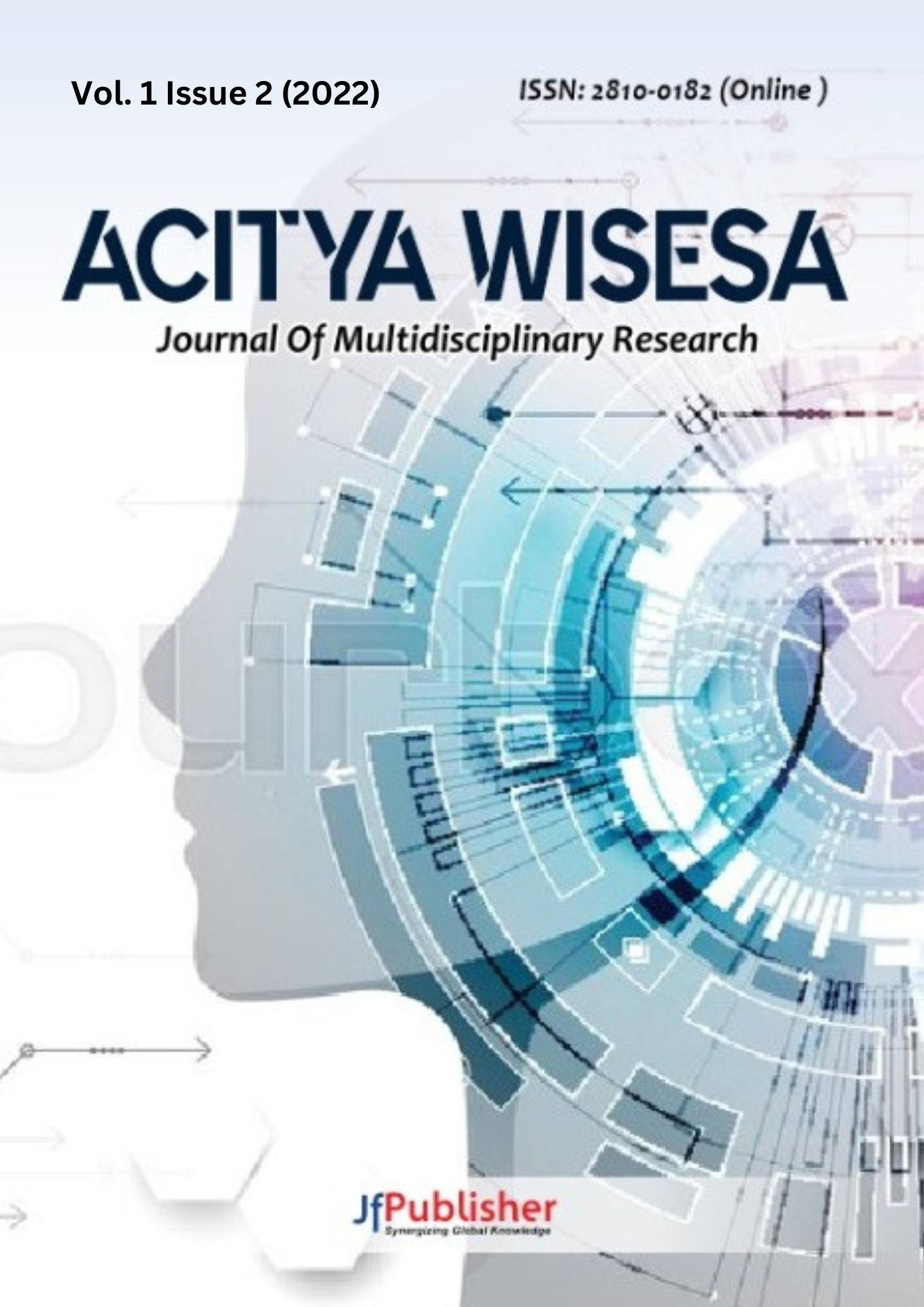ELECTRONIC MEDICAL RECORD ACCEPTANCE: A Literature Review
Postgradute of Hospital Administration, Universitas Muhammadiyah Yogyakarta
Postgradute of Hospital Administration, Universitas Muhammadiyah Yogyakarta
Postgradute of Hospital Administration, Universitas Muhammadiyah Yogyakarta
DOI:
https://doi.org/10.56943/jmr.v1i2.78The implementation of hospital information systems and electronic medical records can improve health care services in hospitals, but there are still many things that inhibits its user acceptance. The purpose of this study is to find out things that can support the acceptance of hospital information systems and medical records by electronic users and their obstacles. This is a literature review research and uses the Preferred Reporting Items for Systematic Reviews and Meta-analyses (PRISMA) methods.Relevant articles were obtained from PubMed in 1982 to June 2021. Articles were selected if they met the criteria in the form of discussing the acceptance of hospital information systems in the form of electronic medical records in hospitals. The result of this research showed that 1535 articles were obtained from PubMed. The same article was deleted with Zotero's delete duplicate feature and manually with the results of 215 relevant articles, 89 articles were selected through abstract reading and 22 articles were obtained for full text reading.A total of 21 journals were analyzed in this review. Factors that affect the acceptance of hospital information systems and electronic medical records are perceived usefulness, perceived ease of use, human-related factors, demographics and the human environment, technological factors, organizational and organizational environmental factors, effort expectancy and performance expectancy. Implementation of information systems and electronic medical records can be maximized by increasing user acceptance of the system so that health services can be provided optimally.
Keywords: Acceptance Behavior Hospital Information System
Abdekhoda, M., Dehnad, A. and Zarei, J. (2019) ‘Determinant factors in applying electronic medical records in healthcare’, Eastern Mediterranean Health Journal, 25(1), pp. 24–33. doi:10.26719/emhj.18.007.
Ahmadian, L. et al. (2017) ‘Challenges of using Hospital Information Systems by nurses: comparing academic and non-academic hospitals’, Electronic Physician, 9(6), pp. 4625–4630. doi:10.19082/4625.
Ahmed, M.H. et al. (2020) ‘Intention to use electronic medical record and its predictors among health care providers at referral hospitals, north-West Ethiopia, 2019: using unified theory of acceptance and use technology 2(UTAUT2) model’, BMC Medical Informatics and Decision Making, 20(1), p. 207. doi:10.1186/s12911-020-01222-x.
Alipour, J., Mehdipour, Y., Karimi, A. (2019) ‘Factors Affecting Acceptance of Hospital Information Systems in Public Hospitals of Zahedan University of Medical Sciences: A Cross-Sectional Study’, J. Med. Life, pp. 403–410.
Amiri, P., Rahimi, B. and Khalkhali, H.R. (2018) ‘Determinant of successful implementation of Computerized Provider Order Entry (CPOE) system from physicians’ perspective: Feasibility study prior to implementation’, Electronic Physician, 10(1), pp. 6201–6207. doi:10.19082/6201.
Baysari, M.T. et al. (2018) ‘Longitudinal study of user experiences of a CPOE system in a pediatric hospital’, International Journal of Medical Informatics, 109, pp. 5–14. doi:10.1016/j.ijmedinf.2017.10.018.
Bourla, A. et al. (2020) ‘Are student nurses ready for new technologies in mental health? Mixed-methods study’, Nurse Education Today, 84, p. 104240. doi:10.1016/j.nedt.2019.104240.
Darby, A.B., Su, Y., Reynolds, R.B., Madlock-Brown, C. (2019) ‘A Survey-based Study of Pharmacist Acceptance and Resistance to Health Information Technology’.
Ebnehoseini, Z. et al. (2020) ‘Understanding key factors affecting on hospital electronic health record (EHR) adoption’, Journal of Family Medicine and Primary Care, 9(8), p. 4348. doi:10.4103/jfmpc.jfmpc_109_20.
Elahi, C. et al. (2020) ‘An Attitude Survey and Assessment of the Feasibility, Acceptability, and Usability of a Traumatic Brain Injury Decision Support Tool in Uganda’, World Neurosurgery, 139, pp. 495–504. doi:10.1016/j.wneu.2020.04.193.
Gagnon, M.-P. et al. (2012) ‘Systematic Review of Factors Influencing the Adoption of Information and Communication Technologies by Healthcare Professionals’, Journal of Medical Systems, 36(1), pp. 241–277. doi:10.1007/s10916-010-9473-4.
Handayani, P.W., Hidayanto, A.N. and Budi, I. (2018) ‘User acceptance factors of hospital information systems and related technologies: Systematic review’, Informatics for Health and Social Care, 43(4), pp. 401–426. doi:10.1080/17538157.2017.1353999.
Hosein, B., Luo, J. and Karami, M. (2019) ‘Adoption of Hospital Information System Among Nurses: a Technology Acceptance Model Approach’, Acta Informatica Medica, 27(5), p. 305. doi:10.5455/aim.2019.27.305-310.
Hwang, H.-G., Dutta, B. and Chang, H. (2019) ‘The Differing Effect of Gender and Clinical Specialty on Physicians’ Intention to Use Electronic Medical Record’, Methods of Information in Medicine, 58(S 02), pp. e58–e71. doi:10.1055/s-0039-1695718.
Jauk, S. et al. (2021) ‘Technology Acceptance of a Machine Learning Algorithm Predicting Delirium in a Clinical Setting: a Mixed-Methods Study’, Journal of Medical Systems, 45(4), p. 48. doi:10.1007/s10916-021-01727-6.
Kisdianata, W., Pribadi, F., F. (2016) ‘Evaluasi Kinerja Sistem Informasi Manajemen Dalam Mendukung Proses Manajemen di Rumah Sakit Gigi dan Mulut UMY’. Available at: https://mars.umy.ac.id/evaluasi-kinerja-sistem-informasi-manajemen-dalam-mendukung-proses-manajemen-di-rumah-sakit-gigi-dan-mulut-umy/.
Litwin, L.E. et al. (2018) ‘Use of an electronic Partograph: feasibility and acceptability study in Zanzibar, Tanzania’, BMC Pregnancy and Childbirth, 18(1), p. 147. doi:10.1186/s12884-018-1760-y.
Mashoka, R.J. et al. (2019) ‘Implementation of electronic medical records at an Emergency Medicine Department in Tanzania: The information technology perspective’, African Journal of Emergency Medicine, 9(4), pp. 165–171. doi:10.1016/j.afjem.2019.07.002.
Nadri, H. et al. (2018) ‘Factors Affecting Acceptance of Hospital Information Systems Based on Extended Technology Acceptance Model: A Case Study in Three Paraclinical Departments’, Applied Clinical Informatics, 09(02), pp. 238–247. doi:10.1055/s-0038-1641595.
Nuryati, - and Widayanti, N.A. (2015) ‘Evaluasi Implementa Si Sistem Electronic Health Record (Ehr) Di Rumah Sakit Akademik Universita S Gadjah Mada Berdasarkan Metode Analisis Pieces’, Jurnal Manajemen Informasi Kesehatan Indonesia, 3(1). doi:10.33560/.v3i1.66.
Omar, A., Ellenius, J., Lindemalm, S. (2017) ‘Evaluation of Electronic Prescribing Decision Support System at a Tertiary Care Pediatric Hospital: The User Acceptance Perspective’, Studies in Health Technology and Informatics, pp. 256–261.
Putri, D.R., S. (2020) Evaluasi Implementasi Electronic Medical Record (EMR) Menggunakan Technology Acceptance Model (TAM) dengan Literature Review. Universitas Jenderal Achmad Yani Yogyakarta.
Thit, W.M. et al. (2020) ‘User Acceptance of Electronic Medical Record System: Implementation at Marie Stopes International, Myanmar’, Healthcare Informatics Research, 26(3), pp. 185–192. doi:10.4258/hir.2020.26.3.185.
Wang, J. et al. (2020) ‘Adoption of an Electronic Patient Record Sharing Pilot Project: Cross-Sectional Survey’, Journal of Medical Internet Research, 22(4), p. e13761. doi:10.2196/13761.

